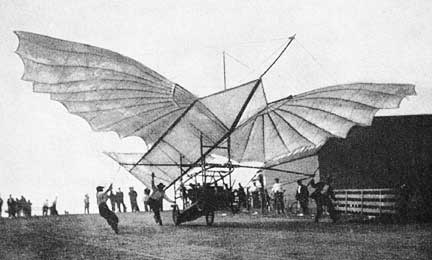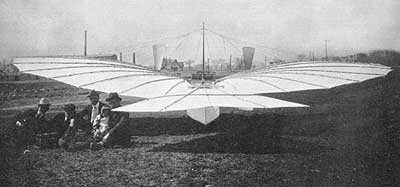


Gustiv Whitehead's 1899 Flying Machine
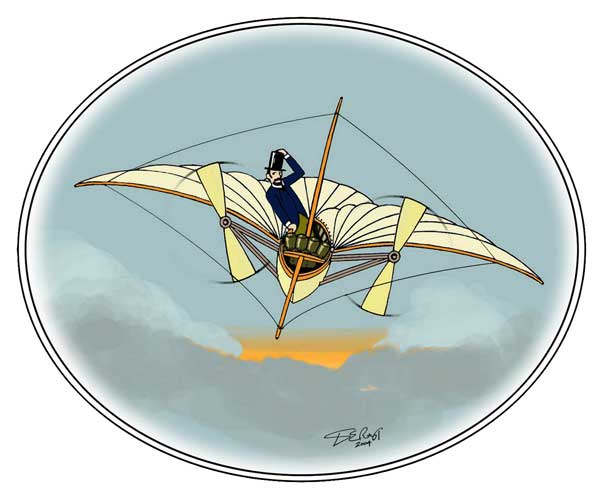
This original artwork by Derek Roberts is available in much higher quality (suitable for framing), on the Full Collection DVD.
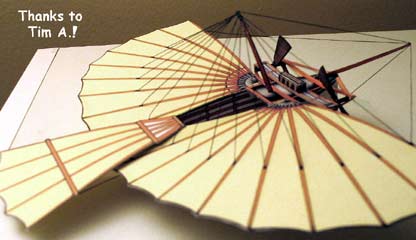
Although today it is a generally accepted fact that the Wright brothers were the first men to perfect a heavier-than-air aircraft, it was not always so.
One enigmatic figure in aviation history whose supporters say he made controlled flights as early as 1899 was Gustave Whitehead, a poor, German immigrant to the United States.
Whitehead clearly built a number of airplanes before the Wrights were successful in 1903 at Kitty Hawk, but did any of his craft really fly?
Kudos to you and your contributing artists, researchers and team members. This early flight (pre-flight?) subject is a wonderful and fascinating area you folks are exploring. I see that, as with all of your models, it's the small and innovative "details" you've included such as the #21's instrument panel with the disclaimer "Please don't email us, this is a joke" that reminds me this hobby is not only educational and inexpensive but just plain fun. I'm sorry Chip, but I simply couldn't resist emailing you about it anyway. ;-)...Skip
I am speechless. I have always been a fan of early aviation and have always fantasized about building a series of early attempts at flying aeroplanes. And now............. it looks like I'll be able to do it.....Anthony 11/03
I always heard stories of flying machines that may have flown before the wrights. It sure is interesting to hear Whitehead's story! Really makes me wonder. Well I guess I will just have to build it and find out myself ;-)....Richard P. 11/03
What a wonderful concept -doing a series of early PRE-Wright airplanes.. Brilliant !!Thank you so very much for bringing so much aviation awareness to the world .Philip B
Thanks for the Whitehead Flyer. The Early Flying Machines look like fun! Will you be releasing those as a CD?--David S
Chip! I like it, I like it, I like it!!! :-)) Wonderful to see our work up on the net, makes the effort all worthwhile! Hats off to you for a great job on the up sizing, it looks a treat! Hope you sell a bundle. Derek Roberts (the contributing designer!)
Whitehead's 1899 Flying Machine
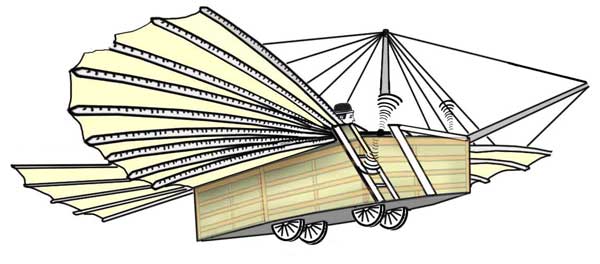
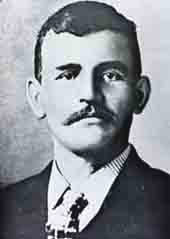 Gustave Whitehead, 1874-1927 Gustave Whitehead, 1874-1927 |
Whitehead, who Americanized his name from Weisskopf when he immigrated from Bavaria, Germany, was a mechanic by trade who lived and worked in Boston, New York, Buffalo, Tonawanda, Johnstown, Pittsburgh, and finally Bridgeport, Connecticut around the turn-of-the-century. According to at least one biography, Whitehead was fascinated by aviation from an early age and was inspired by the glider flights of Otto Lillienthal to built his own model glider at age 13. Skeptics point out this is surely a mistake or exaggeration since Whitehead was 13 in the year 1887, well before Lillienthal started his glider experiments.
According to an article in the January 1935 edition of Popular Aviation written by Stella Randolf and Harvey Phillips, Whitehead made his first flight in a steam-driven aircraft just outside Pittsburgh in the spring of 1899. Two years later, in August 1901, he made another flight with a gas-powered plane (which he designated as "Number 21") near the town of Bridgeport, Connecticut. In 1902 he made a flight with an aircraft numbered "22" that flew over Long Island Sound. If true, these flights would have meant Whitehead proceeded the Wright Brothers into the air by at least one, or maybe even three years.
Unfortunately there is little information or evidence about the existence of the Pittsburgh flight. The account in Popular Aviation tells us that Whitehead hadn't expected the new airplane to go as far as it did, and he crashed into a building, destroying the craft:
But as they went onward and upward, steered by Gustave Whitehead at the controls in the front, they exceeded the distance originally planned and found themselves headed for a three-story brick house. Afraid to attempt to swerve, there was but one hope, namely that they might clear the top of the house. But they failed. Down fell the machine, all but demolished, while the agonized fireman in the back writhed with the pain of a scalded leg. The glasses for indicating water-level in the boilers had broken, permitting steam to envelop the man.
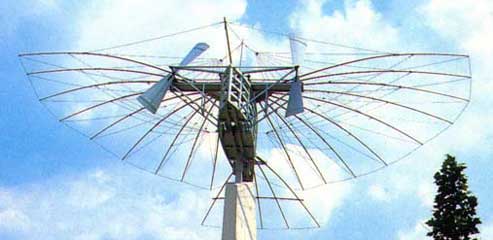
Bridgeport Herald News Report...June 8, 1901
A New Flying Machine:....A novel flying machine has just been completed by Mr. Gustave Whitehead, of Bridgeport, Conn., and is now ready for the preliminary trials. Several experiments have been made, but as yet no free flights have been attempted. The machine is built after the model of a bird or bat. The body is 16 feet long and measures 2 1/2 feet at its greatest width and is 3 feet deep.
It is well stayed with wooden ribs and braced with steel wires and covered with canvas which is tightly stretched over the frame, Four wheels, each one foot in diameter, support it while it stands on the ground. The front wheels are connected to a l0 horse power engine to get up speed on the ground, and the rear wheels are mounted like casters so that they can be steered by the aeronaut.
On either side of the body are large 'aeroplanes', covered with silk and concave on the underside, which give the machine the appearance of a bird in flight. The ribs are bamboo poles, and are braced with steel wires. The wings are so arranged that they can be folded up. The 10-foot rudder, which corresponds to the tail of a bird, can also be folded up and can be moved up and down, so as to steer the machine on its horizontal course.
A mast and bowsprit serve to hold all the parts in their proper relation. In front of the wings and across the body is a double compound engine of 20 horse power, which drives a pair of propellers in opposite directions, the idea being to run the machine on the ground by means of the lower engine until it has the necessary speed to rise from the ground. Then the upper engine actuates the propellers so as to cause the machine to progress through the air to make it rise on its aeroplanes.
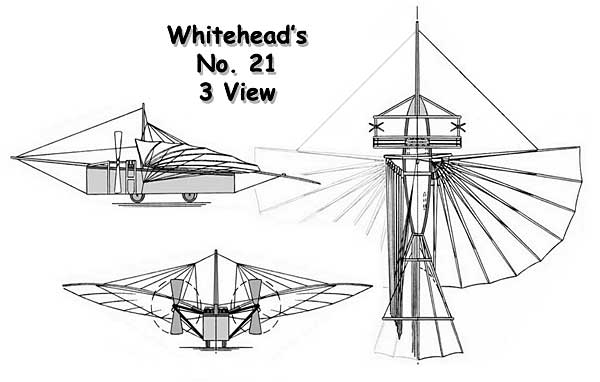
Even the most ardent Whitehead supporters admit that proof of the Pittsburgh experiment is lacking. More evidence is available of the Bridgeport flights, though. The plane Whitehead constructed at Bridgeport was, according to the Popular Aviation article:
...a monoplane with a four-cylinder two-cycle motor located forward. Ignition was of the make and break type and Columbia dry batteries were used. The gas tank was gravity-fed and held two gallons of petrol. The body of the machine was constructed of pine, spruce, and bamboo, reinforced with Shelby steel tubing and piano wires. The wing coverings were of Japanese silk, varnished and fastened to the bamboo struts with white tape. The wings spread out behind the two propellers, and were supported with wires running to a central mast. The entire thing weighed approximately 800 pounds. With Mr. Whitehead aboard the weight was increased to about 965 pounds.
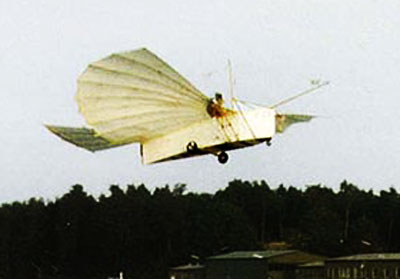 This is reproduction of the Whitehead #21 Flying Machine |
On August 14, 1901, or so the story goes, Whitehead made a test flight near the location which was later to become the Sikorsky airplane factory. He flew the machine for one and a half miles that day. According to the Popular Aviation article the authors interviewed Junius Harworth, who had been a young boy assisting Whitehead. Harworth said he remembered the flight distinctly and in detail.
The next January Whitehead was ready with a new machine, which he tested on the 17th. Again Popular Aviation:
Gustave Whitehead took his place at the controls of the machine, the men gave it a preliminary push, and it trundled away on its three wheels and was off! The plane performed so admirably that its owner continued his flight for a distance of two miles over the Sound, following the shore line of the beach, although he had intended to make only short flights of not more than half a mile. The men pulled it ashore, and now Gustave Whitehead proposed to fly across the Sound.
|
According to the article Whitehead never made it across the Sound, but turned back, deciding to test the ability to turn the plane instead.
As interesting as the assertions in the Randolf and Phillips article were, they were written more than three decades after the incidents depicted and nine years after Whitehead's death in 1927. Evidence more contemporary to the events would be helpful in establishing the truth of the matter. This came in the form of an article in The Bridgeport Herald newspaper from August 18, 1901. The author states he witnessed a night test of the plane, at first un piloted but loaded with sand bags, and later with Whitehead at the controls. Such a news report would seem clinching evidence that the flight had taken place, yet skeptics point out that the story has holes in it.
The first is that the aircraft was tested early in the morning before sunrise. With primitive flying technology getting a plane into the air would be dangerous during the day and certainly suicidal at night. Also, the idea that the plane could be tested with no pilot, but only sand bag ballast seems absurd. Early flying machines were tricky to handle and an un piloted test flight would almost certainly have resulted in a crash.
Why would a newspaper report a successful flight if it didn't really occur? Though it has virtually disappeared from the mainstream newspaper business, in the 19th and early 20th century hoax journalism was widely practiced. For this reason outlandish stories dating from that period cannot be taken at face value. It would not be inconceivable at all that a reporter looking for a story might have come across Whitehead and his flying machines and decided to say that he actually witnessed a test flight that had never occurred.
How do we know that Whitehead built airplanes at all? On that point
there is some pretty solid evidence. There are a number of photos showing
Whitehead with different flying machines that he'd constructed. Unfortunately
none of them show any of his powered machines actually up in the air,
though they do confirm that one of his gliders flew. Such a photo of
a powered-flying machine would have gone a long way toward proving Whitehead's
claims. 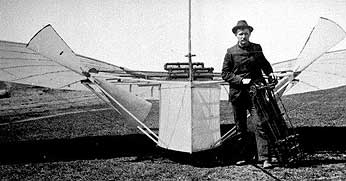
Other evidence that would establish Whitehead's success at getting into the air would have been plans of the aircraft he built along with notes or letters documenting the progress of his aviation experiments. Whitehead, except for a few letters to Scientific American about his flights, left no paper trail to follow. Of course, Whitehead's supporters point out that the German immigrant was not a man a letters, but a mechanic, and the fact that he simply did not bother to document his flights does not mean that he did not actually make them.
In 1936, after the Popular Aviation article appeared, The Harvard University Committee on Research in the Social Sciences sent John Crane, a professor of economics, to Connecticut to get to the bottom of the story. Crane published his conclusions in an article in the National Aeronautical Association Magazine in December 1936 entitled "Did Whitehead Actually Fly?" According to Crane, after interviewing many Bridgeport residents and Whitehead's family, he only found one person who remembered the flights and that person had a financial interest in a book that Stella Randolf was writing on Whitehead.
It seems impossible to establish positively from the historical record that Whitehead made the flights, but can we know if his designs were capable of flight?
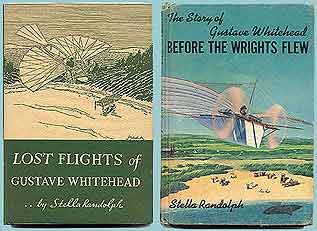 There have been several attempts to rebuild some of Whitehead's aircraft
and fly them. In the late 1980's a group studied pictures of number
"21" and drew up plans for an aircraft based on them. These
plans were then used by The Historical Flight Research Committee Gustave
Whitehead (HFRC-GV) in Germany to build an aircraft which was successfully
flight tested in 1997.
There have been several attempts to rebuild some of Whitehead's aircraft
and fly them. In the late 1980's a group studied pictures of number
"21" and drew up plans for an aircraft based on them. These
plans were then used by The Historical Flight Research Committee Gustave
Whitehead (HFRC-GV) in Germany to build an aircraft which was successfully
flight tested in 1997.
While the test shows that Whitehead's design might have flown, it does not prove that it actually did. Without plans drawn up by Whitehead himself, there is no way of knowing for sure if the reproduction was truly accurate.
Also, the reproduction aircraft used a modern "unltralight" engine and propeller which probably produced significantly more thrust than the Whitehead's original engine/propeller combination would have had. Since engine weight vs. power was a significant hurtle for early aviators, this alone might have rendered a workable aircraft design un flyable.
Whitehead supporters point to an unusual deal made between the Smithsonian Institution and the Wright Brothers estate as one of the reasons why information about Whitehead's flights were suppressed.
Though the Wright Brothers are generally recognized as the first to
build a successful powered airplane today, that was not the case in
the early 1900's. The Wright Brothers fought to protect their patents
while other airplane builders tried to find either ways around the patents
or ways to make them invalid. Glenn Curtiss rebuilt an experimental
airplane designed by Samuel Langley of the Smithsonian Institution to
try and show that other aircraft could have flown before the
Wright's Flyer did. This caused a schism between the Smithsonian
Institution and the Wright Brothers and for this reason the Flyer
was not exhibited in the Smithsonian until 1948. When it finally was,
it was only with the agreement that: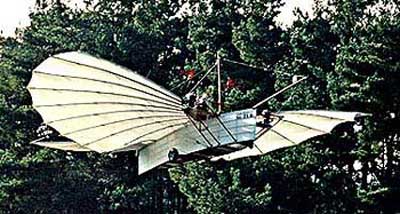
Neither the Smithsonian Institution or its successors, nor any museum or other agency, bureau or facilities administered for the United States of America by the Smithsonian Institution or its successors shall publish or permit to be displayed a statement or label in connection with or in respect of any aircraft model or design of earlier date than the Wright Airplane of 1903, claiming in effect that such aircraft was capable of carrying a man under its own power in controlled flight.
So did Gustave Whitehead really beat the Wright Brothers into the
sky?
This is an issue that is never likely to be settled to everyone's
satisfaction. Clearly the evidence for his flights are too thin to overturn
the Wright's Brothers place in the minds of most historians. However,
there are a lot of people who believe, and will continue to believe,
that Whitehead was successful in getting an aircraft into the air several
years before the Wright's Flyer left the ground at Kitty Hawk
in December of 1903. It is interesting for the rest of us to consider
whether the history of flight might be considerably changed if someone
had thought to bring a camera to an empty field outside of Bridgeport
early one morning in 1901.
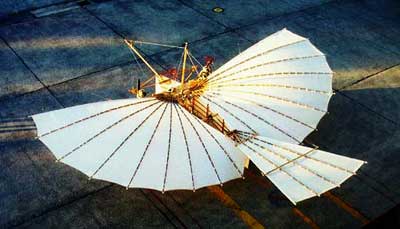 He continued building and experimenting with airplanes, and his supporters
claim that he made powered flights in both Pittsburgh in 1899 and Bridgeport
in 1901 and early 1902. His letters to periodicals and interviews in
newspapers claim powered flights as early as 1898 and as late as 1903.
He was, in fact, one of a several turn-of-the-century experimenters
who regularly issued press releases that described successful flights
with no real evidence to back his claims. Whitehead made his last airplane
in 1908 - which did not fly - then went on to build helicopters which
did not fly.
He continued building and experimenting with airplanes, and his supporters
claim that he made powered flights in both Pittsburgh in 1899 and Bridgeport
in 1901 and early 1902. His letters to periodicals and interviews in
newspapers claim powered flights as early as 1898 and as late as 1903.
He was, in fact, one of a several turn-of-the-century experimenters
who regularly issued press releases that described successful flights
with no real evidence to back his claims. Whitehead made his last airplane
in 1908 - which did not fly - then went on to build helicopters which
did not fly.
The memory of Gustave Whitehead's aeronautical experiments faded as powered flight became a reality. They were briefly resurrected in 1913 during the "Patent Wars" between the Wright brothers and Glenn Curtiss. Curtiss' lawyers considered raising the possibility that Whitehead and others may have preceded the Wrights in powered flight but decided not to pursue this strategy, possibly for lack of evidence. Instead, Curtiss set about rebuilding Samuel Langley's Great Aerodrome that had crashed into the Potomac in 1903 to prove that it could have flown before the Wrights.
And there the matter rested until January 1935, when the magazine Popular Aviation published an article about Whitehead - "Did Whitehead Precede Wright In World's First Powered Flight?" by Stella Randolph and Harvey Phillips. The parts of this long article that made the readers sit up and take notice were the accounts of three powered flights, all alleged to have taken place before the Wright brother's first powered flight on December 17, 1903.
1899 "...in the Oakland suburb of Pittsburgh in the Spring of 1899, [a]steam-driven model had carried him and his assistant a distance of almost a mile. Firemen lent their assistance that time to start the machine, while the assistant fed charcoal to the flame which heated water in the ordinary kitchen boiler which they were using. [A]s they went onward and upward, steered by Gustave Whitehead at the controls in the front, they exceeded the distance originally planned and found themselves headed for a three-story brick house. Afraid to attempt to swerve, there was but one hope, namely that they might clear the top of the house. But they failed. Down fell the machine, all but demolished, while the agonized fireman in the back writhed with the pain of a scalded leg."
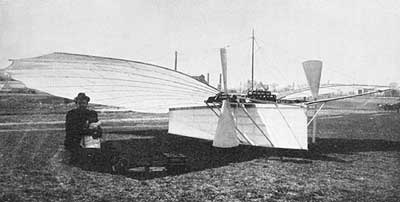 Whitehead with daughter Rose posing next to his aircraft Whitehead#21 - ca. 1901 Whitehead with daughter Rose posing next to his aircraft Whitehead#21 - ca. 1901 |
1901 "The mile and a half flight, made August 14, 1901, occurred at Lordship Manor, now a suburb of Bridgeport...One day, [the No. 21 airplane] was pushed into the street from the backyard of the modest house, 241 Pine Street, which was then the Whitehead home. Inside it, two engines were humming, one for propelling the wheels on which it was to get its start upon the ground, the other to turn the propellers when the machine was in the air. The small boys of the neighborhood came running, attracted by the unusual. They drew excited breaths of awe, and whistled through their teeth as the creature dashed down the road, rose from the ground, not many feet higher than their heads, and flew above the dirt road that was then Pine Street."
1902 "On the afternoon of January 17, 1902, the weather looked promising. It was the day [Whitehead] and his helpers had been seeking, so they quietly took their new avion, No. 22, to the beach outside Bridgeport and started its kerosene motor. Gustave Whitehead took his place at the controls of the machine, the men gave it a preliminary push, and it trundled away on its three wheels and was off! The plane performed so admirably that its owner continued his flight for a distance of two miles over the Sound, following the shore line of the beach. The men pulled it ashore, and now Gustave Whitehead proposed to fly across the Sound.
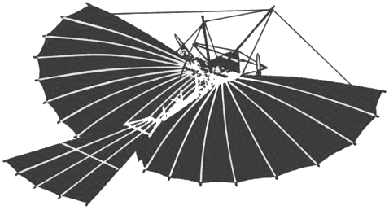 He took off again [and] was steadily progressing out across the
Sound when it occurred to him that it might be interesting to see if
he could make his machine turn. He turned the rudder slowly and drove
one propeller faster than the other. Steadily and rapidly the machine
came about until he was facing his starting point. As he neared his
rejoicing helpers on the shore, he slowed the speed of the plane and
again dropped it gently into the water. It had traveled a distance of
approximately seven miles, not across the Sound, but it had made the
first turn in the air so far as has been recorded".
He took off again [and] was steadily progressing out across the
Sound when it occurred to him that it might be interesting to see if
he could make his machine turn. He turned the rudder slowly and drove
one propeller faster than the other. Steadily and rapidly the machine
came about until he was facing his starting point. As he neared his
rejoicing helpers on the shore, he slowed the speed of the plane and
again dropped it gently into the water. It had traveled a distance of
approximately seven miles, not across the Sound, but it had made the
first turn in the air so far as has been recorded".
The wings are immovable and resemble the outstretched wings of a soaring bird. The steering will be done by running one propeller faster than the other in a way analogous to the way in which an ocean steamer having twin screws can be turned, a special aeroplane being provided to maintain longitudinal and transverse stability.
The lower engine is of 10 horse power, and weighs 22 pounds. The diameter of the cylinder is 3 7-16 inches by 8 inches stroke. The upper engine is a double compound cylinder, the diameters being 2 1/4 and 3 7-16 inches with a 7-inch stroke. The engine weighs 35 pounds, and calcium carbide is used to develop pressure by means of explosions.
The propellers weigh 12 pounds, and are 6 feet in diameter, with a projected blade surface of 4 square feet. With a draw bar test, the upper engine being run at full speed, the dead pull was 365 pounds. The weight of the body and wheels is 45 pounds. The wings and tail have 450 square feet of supporting surface, and the weight is 35 pounds.
There
are probably many reasons that Gustave Whitehead, like so many pioneering
inventors never achieved any recognition for his work.
|
His profound disorganization: Here was a man who kept no records of any business or technical transactions he made. His goal was to fly, not to be recorded as the first to fly, thus keeping track of times, lengths and heights or making sure there were records on photograph were not the priority of his work. All witnesses, save his assistants, were accidental, he did not even make sure that his wife was present at any of his August 14 flights.
His extreme poverty: All of Whitehead's money went to the construction of his heavier than air flying machines - an editor of the Bridgeport Post who knew Whitehead said of him, "Let Whitehead earn two dollars and a half - enough to purchase a block of steel, and he was off again on his favorite hobby of constructing airplanes." He certainly wouldn't have been able to afford to patent his invention even if that had been his goal.
He was dissatisfied with his own work: He was never satisfied with these short flights and bumpy rides and did not see what he had done as success. Therefore, he did little to publicize his work, feeling that it all fell short of his own expectations.
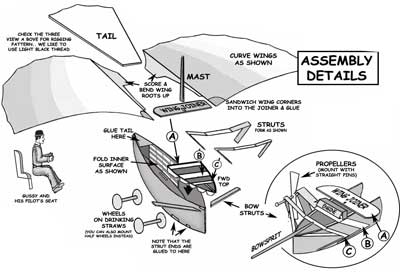
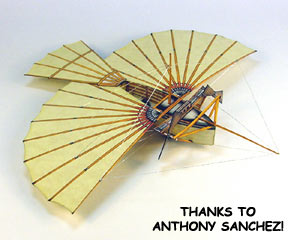
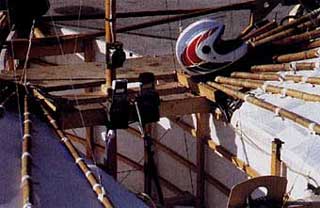 |
Cockpit of the Whitehead Replica. |



